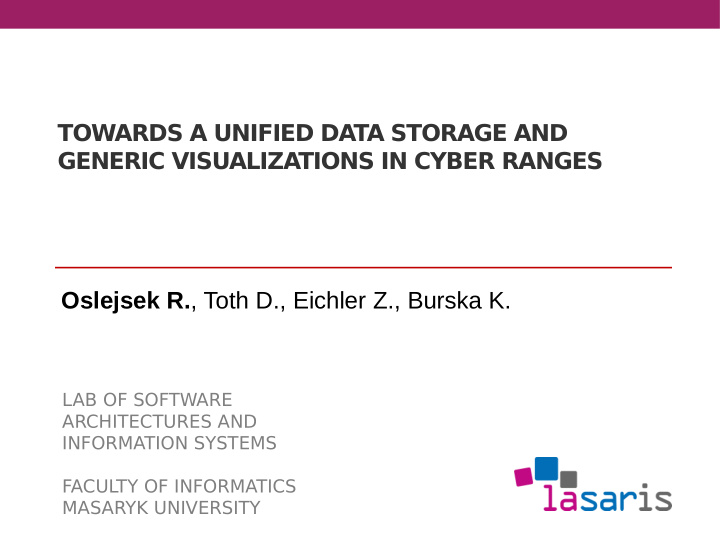



TOWARDS A UNIFIED DATA STORAGE AND GENERIC VISUALIZATIONS IN CYBER RANGES Oslejsek R. , Toth D., Eichler Z., Burska K. LAB OF SOFTWARE ARCHITECTURES AND INFORMATION SYSTEMS FACULTY OF INFORMATICS MASARYK UNIVERSITY
2/12 R. Ošlejšek, ECCWS‘2017, 29. 6. 2017 Cyber Ranges Emulate computer networks Enables to perform cyber security exercises and experiments They difger in emulation possibilities (traffjc emulation), application domain (training, learning, forensic analysis), architecture (IaaS, PaaS, SaaS , ...) …
3/12 R. Ošlejšek, ECCWS‘2017, 29. 6. 2017 Cyber Ranges – Common Features Common services provided by cyber ranges: Resource management – allocation of network infrastructure with required topology and running applications. Interaction of users with hosts – allowing users to log into hosts and run applications there. Data monitoring – network activities are monitored on the fmy and measured data is stored for further analysis and mediation to users. Providing insight into cyber threats – by providing users with interactive visualizations, analytical tools, and other interactive techniques.
4/12 R. Ošlejšek, ECCWS‘2017, 29. 6. 2017 KYPO Cyber Range – Key Features Cloud-based virtualization Allocation of (multiple) sandboxes on demand SW emulation of links, switches, hosts, ... Generic cyber range supporting user-defjned security scenarios Goal: KYPO as a service (SaaS) End users can interact with sandboxes easily via predefjned user interfaces and without the need to install anything by themselves
5/12 R. Ošlejšek, ECCWS‘2017, 29. 6. 2017 Challenge 1: Data Monitoring Data monitoring We do not know in advance what data are to be monitored for particular scenario. Common phenomena monitored natively Ex.: packets, fmows, CPU load Scenario-specifjc phenomena monitored by specialized probes integrated to the cyber range infrastructure Ex.: availability of services, average link throughput, … Requires access to the virtualization layer or to the low-level cyber range infrastructure Requires skills, competences and deep knowledge of the cyber range It is annoying and time consuming for end users (domain experts) Goal: Provide a unifjed data monitoring and storage infrastructure at the user level (as a service)
6/12 R. Ošlejšek, ECCWS‘2017, 29. 6. 2017 Unifjed Scheme for Data Storage Adapted Observation pattern of Martin Fowler Knowledge level What is to be measured => scenario-specifjc data phenomenon_type = common network phenomena phenomenon = predefjned values of network phenomena measurement_type = aggregated data (higher-level interpretation, e.g. average throughput in 5 min interval ) measurement_type measured_phenomenon_type phenomenon_type supported values phenomenon name text name text name text unit text knowledge level observed phenomenon category_observation monitored_element who measured and where observation measurement timestamp value text operational level
7/12 R. Ošlejšek, ECCWS‘2017, 29. 6. 2017 Unifjed Scheme for Data Storage (cont.) Operational level Data measured by probes => exercise-specifjc data measurement = value from “unlimited” domain (e.g. numerical) category_observation = predefjned value measurement_type measured_phenomenon_type phenomenon_type supported values phenomenon name text name text name text unit text knowledge level observed phenomenon category_observation monitored_element who measured and where observation measurement timestamp value text operational level
8/12 R. Ošlejšek, ECCWS‘2017, 29. 6. 2017 Challenge 2: Data Visualization Mediation of data to users Variable data Scenario-specifjc data Variable user interests The same data analyzed in difgerent ways by difgerent domain experts Approach 1: Use specialized analytical or visualization tools deployed in sandboxes by users themselves T ools usually require a specifjc format of data sources => adaptation of the monitoring infrastructure Approach 2: Provide user interfaces as a service A scenarist composes scenario-specifjc user interfaces from predefjned visual/interactive blocks End users (domain experts) utilize them directly
9/12 R. Ošlejšek, ECCWS‘2017, 29. 6. 2017 Adaptable User Interfaces Enterprise web portals (JSR 168 and JSR 286) Portlets integrated to page templates and site templates interactively at the user level Portlets: Narrowly focused Mutually connectable to provide higher-level interactions Highly confjgurable
10/12 R. Ošlejšek, ECCWS‘2017, 29. 6. 2017 Evaluation Attack demonstrations DDOS and phishing scenarios for security experts Hacking games Cca 10 capture-the-fmag games From kids to security experts Cyber Czech Defense Exercise Realistic 2 days defense exercise in the cooperation with Czech National Security Authority 6 runs, complex scenario with 5 defending and 1 attacking teams KYPO Lab – regular cyber-security course Students design their own security scenarios inspired by real threats and attacks Other students play these scenarios at the end of semester
11/12 R. Ošlejšek, ECCWS‘2017, 29. 6. 2017 Conclusion and Future Work Unifjed monitoring. Setting up the monitoring infrastructure is very laborious and still far from automation. NoSQL databases. Possibly better adaptation to variable data. Do not solve the problem of data interpretation and mediation to users. Confjgurability of portlets. Visualization and interaction features depending on dynamic (scenario-specifjc) roles, e.g. attacker vs. defender.
12/12 R. Ošlejšek, ECCWS‘2017, 29. 6. 2017 Questions? Thank you for your attention www.kypo.cz
Recommend
More recommend